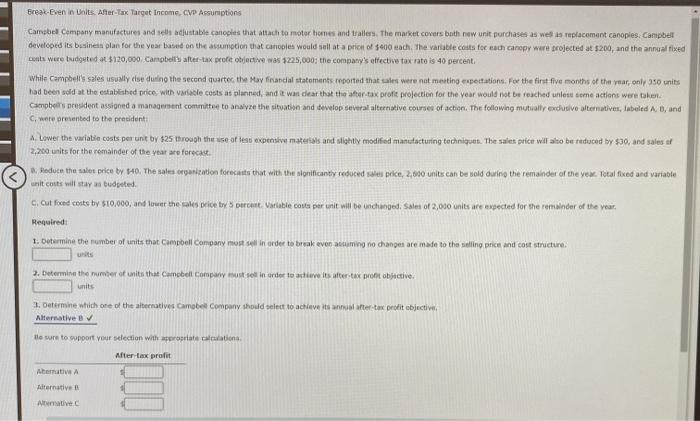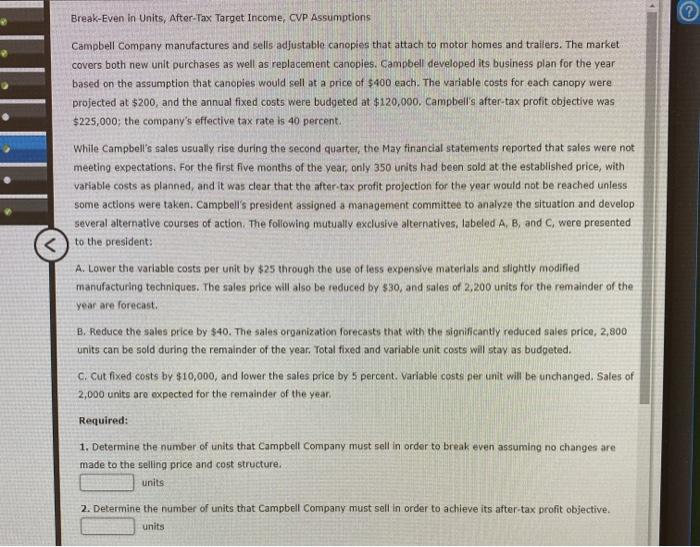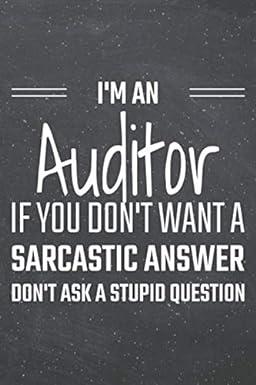Break-Even in Units. After Tax Target Income, CVP Assumptions Cambel Company manufactures and tells adjustable canopies that attach to motor homes and trailers. The market covers both new unit purchases as well as replacement canopies. Campbell developed its business plan for the year based on the assumption that canopies would sell at a price of $400 each. The variable costs for each canopy were projected at $200, and the annual fixed cents were tridguted at $120,000. Campbells after-tax profit objective was $225,000; the company's effective tax rate is 40 percent While Campbell's sales susly else during the second quarter the May financial statements reported that takes were not meeting expectations. For the first five months of the year, only 350 units had been sold at the established price with variable costs as planned, and it was clear that the after tax profit projection for the year would not be reached unless some actions were taken Camphery president assigned a management committee to analyze the situation and develop several alternative course of action. The following mutually exdusive alternativet, tabeled AB, and C were presented to the president A. Lower the variatio conts per unt by $25 through the use of tent vxpensive materials and slightly modified manufacturing techniques. The sales price will also be reduced by $30, and sales et 2,200 units for the remainder of the year are forecast Heduce the sale price by Ho. The sales organization forecasts that with the significantly reduced sales price, 2,000 units can be sold during the remainder of the yox. Total fixed and variable unit costs will stay as budgeted. C. Cut food costs by $10,000, and towar the sole price by 5 percent. Variable cauta per unit will be unchanged, Sales of 2,000 units are expected to the remainder of the year, Required: 1. Determine the number of units that Campbell Company must sell in order to break evenming no changes are made to the selling price and cost structure 3. Determine the number of units that Campbell Company stol in ander to achieve its after tax prontobjective units 3. Determine which one of the alternatives Campbell Company should select to achieve its annutter-tax profit objective Alternative te sure to support your selection with prostate cacation After tax profit Ahernative Alternative Avec Break-Even in Units, After-Tax Target Income, CVP Assumptions Campbell Company manufactures and sells adjustable canopies that attach to motor homes and trailers. The market covers both new unit purchases as well as replacement canopies. Campbell developed its business plan for the year based on the assumption that canopies would sell at a price of $400 each. The variable costs for each canopy were projected at $200, and the annual fixed costs were budgeted at $120,000. Campbell's after-tax profit objective was $225,000; the company's effective tax rate is 40 percent. While Campbell's sales usually rise during the second quarter, the May financial statements reported that sales were not meeting expectations. For the first five months of the year, only 350 units had been sold at the established price, with variable costs as planned, and it was clear that the after-tax profit projection for the year would not be reached unless some actions were taken. Campbell's president assigned a management committee to analyze the situation and develop several alternative courses of action. The following mutually exclusive alternatives, labeled A B, and C, were presented to the president: A. Lower the variable costs per unit by $25 through the use of less expensive materials and slightly modified manufacturing techniques. The sales price will also be reduced by $30, and sales of 2, 200 units for the remainder of the year are forecast B. Reduce the sales price by $40. The sales organization forecasts that with the significantly reduced sales price, 2,800 units can be sold during the remainder of the year. Total fixed and variable unit costs will stay as budgeted. c. cut fixed costs by $10,000, and lower the sales price by 5 percent. Variable costs per unit will be unchanged. Sales of 2,000 units are expected for the remainder of the year. Required: 1. Determine the number of units that Campbell Company must sell in order to break even assuming no changes are made to the selling price and cost structure. units 2. Determine the number of units that Campbell Company must sell in order to achieve its after-tax profit objective units









